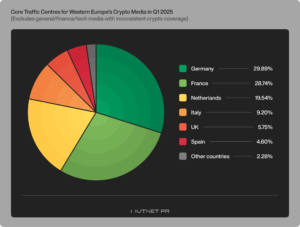Enhancing Liquidity with Cross-Chain Bridges

Enhancing Liquidity with Cross-Chain Bridges
Liquidity is the lifeblood of any financial market, and the decentralized finance (DeFi) space is no exception. In DeFi, liquidity refers to the availability of assets that can be bought or sold without causing significant price slippage. To enhance liquidity in the DeFi ecosystem, cross-chain bridges have emerged as a vital infrastructure. These bridges enable the seamless transfer of assets between different blockchain networks, opening up new possibilities for liquidity pools and deepening market depth.
Understanding Liquidity in DeFi
Before diving into the role of cross-chain bridges, it’s important to understand liquidity in the DeFi space. In simple terms, liquidity is the ease with which assets can be converted into cash or other tradable assets without affecting their market prices. Liquidity allows users to buy and sell assets quickly and efficiently, facilitating the smooth operation of financial protocols.
Introducing Cross-Chain Bridges
Cross-chain bridges are technological solutions that enable the transfer of assets between different blockchain networks. They act as connectors, bridging the gap between isolated networks and facilitating the movement of assets from one blockchain to another. These bridges enable interoperability and the seamless transfer of tokens, enhancing the overall liquidity of the DeFi ecosystem.
Benefits of Cross-Chain Bridges

Cross-chain bridges bring several key benefits to the DeFi space:
Asset Interoperability and Accessibility
One of the primary benefits of cross-chain bridges is the enablement of asset interoperability. Assets that are native to one blockchain can be seamlessly transferred to another blockchain via these bridges. This expands the range of assets that users can access and utilize in different DeFi protocols, unlocking new opportunities for liquidity provision and trading.
Market Expansion and Diversification
Cross-chain bridges contribute to the expansion and diversification of DeFi markets. By connecting liquidity pools from multiple blockchain networks, these bridges enable users to access a broader range of assets. This increased market access attracts more participants, leading to higher trading volumes, improved liquidity, and enhanced market depth.
Improving Price Stability and Slippage
Deep liquidity is essential for maintaining price stability and minimizing slippage in trading. Cross-chain bridges aggregate liquidity from different sources, increasing the overall liquidity available in the DeFi ecosystem. With deeper liquidity, larger buy or sell orders can be executed without causing significant price fluctuations, ensuring a more stable trading environment for participants.
The Role of Cross-Chain Bridges in Liquidity Pools
Cross-chain bridges play a crucial role in enhancing liquidity pools within the DeFi ecosystem. These bridges allow liquidity providers to deposit assets into liquidity pools that span multiple blockchain networks. By pooling assets together, liquidity providers increase the overall liquidity available for trading, enabling efficient and seamless transactions. The interoperability facilitated by cross-chain bridges leads to larger liquidity pools and a wider range of tradable assets, attracting more participants and fostering liquidity growth.
Deepening Market Depth with Cross-Chain Bridges
Market depth refers to the ability of a market to handle large buy or sell orders without causing significant price fluctuations. Cross-chain bridges contribute to deepening market depth by connecting liquidity from different sources and blockchain networks. This consolidation of liquidity enables the market to absorb larger trades without substantial slippage, improving trading efficiency and overall market stability. Deeper market depth encourages increased participation from traders and investors, creating a more robust and liquid market environment.
Leveraging Cross-Chain Bridges for Efficient Arbitrage
Cross-chain bridges also provide opportunities for efficient arbitrage trading. With the ability to transfer assets seamlessly between different blockchain networks, arbitrageurs can take advantage of price discrepancies across markets. They can buy assets on one blockchain where the price is lower and sell them on another blockchain where the price is higher, profiting from the price differences. This arbitrage activity helps align prices across connected markets, improving overall market efficiency.
Challenges and Mitigation Strategies
While cross-chain bridges bring significant benefits, they also present challenges that need to be addressed:
- Security: Ensuring the security of asset transfers across different blockchain networks is of utmost importance. Bridge projects need to implement robust security measures, conduct thorough audits, and employ decentralized governance mechanisms to protect users’ assets.
- Scalability: As the number of blockchain networks and DeFi protocols continues to grow, scalability becomes a challenge. Bridge projects need to focus on scalability solutions to handle the increasing demand for cross-chain transfers efficiently.
- Interoperability Standards: Interoperability standards across different blockchain networks are still evolving. Developing and adopting common standards will facilitate smoother asset transfers and improve cross-chain compatibility.
- Regulatory Landscape: The regulatory landscape for DeFi and cross-chain bridges is still evolving. Bridge projects need to navigate regulatory requirements and ensure compliance to foster trust and widespread adoption.
The Role of Cross-Chain Bridges in Liquidity Provision
Cross-chain bridges play a vital role in facilitating liquidity provision within the DeFi ecosystem. By connecting different blockchain networks, these bridges enable the movement of assets and the pooling of liquidity across multiple platforms. This creates a more interconnected and efficient liquidity ecosystem, benefiting both liquidity providers and users.
Liquidity providers contribute to the liquidity pools by depositing their assets into these pools. With the help of cross-chain bridges, liquidity providers can access a wider range of DeFi protocols and platforms, allowing them to maximize their asset utilization and earn yield through various liquidity provision strategies. The ability to transfer assets seamlessly across chains enhances the flexibility and efficiency of liquidity provision, attracting more participants and bolstering the overall liquidity within the DeFi space.
The Impact of Cross-Chain Bridges on Market Depth
Market depth refers to the ability of a market to absorb large buy or sell orders without causing significant price fluctuations. Cross-chain bridges have a profound impact on market depth by consolidating liquidity from various sources and making it accessible across different blockchain networks.
With the help of cross-chain bridges, liquidity from different chains is aggregated, creating deeper and more robust liquidity pools. This increased market depth allows for larger trading volumes and facilitates the execution of substantial orders without substantial slippage. As a result, market participants can engage in more significant transactions with confidence, which contributes to the overall stability and efficiency of the market.
Moreover, cross-chain bridges enable market participants to access a broader range of assets from different chains. This diversification of assets further enhances market depth by attracting a larger pool of traders and investors, increasing overall trading activity, and fostering a more liquid and vibrant market environment.
Leveraging Cross-Chain Bridges for Efficient Capital Allocation
Cross-chain bridges offer opportunities for efficient capital allocation within the DeFi ecosystem. By enabling the seamless transfer of assets between different blockchain networks, cross-chain bridges empower market participants to allocate their capital strategically across various protocols and chains.
Market participants can take advantage of cross-chain bridges to optimize their capital allocation strategies. They can identify opportunities where assets are undervalued or overvalued on different chains and use cross-chain bridges to move their assets to the chain where they can fetch the best returns. This efficient capital allocation contributes to the overall growth and efficiency of the DeFi market, as it enables resources to flow to their most productive uses.
The Importance of Interoperability Standards for Cross-Chain Bridges
Interoperability standards play a crucial role in the effectiveness and scalability of cross-chain bridges. With the increasing number of blockchain networks and protocols, having standardized mechanisms for asset transfer and interoperability is essential for seamless and secure cross-chain transactions.
The development and adoption of interoperability standards enable cross-chain bridges to operate more efficiently and securely. These standards ensure compatibility between different blockchain networks, allowing for seamless asset transfers and reducing the complexity and risks associated with cross-chain transactions.
By establishing interoperability standards, the DeFi community can foster collaboration and innovation, enabling cross-chain bridges to function effectively across different blockchain ecosystems. This further enhances the liquidity, accessibility, and overall growth of the DeFi space.
The Future of Cross-Chain Bridges and Liquidity Enhancement
The future of cross-chain bridges is promising. As blockchain technology evolves and becomes more interconnected, cross-chain bridges will play an increasingly vital role in enhancing liquidity in the DeFi ecosystem. We can expect further advancements in interoperability, scalability, and security, leading to a more seamless and efficient transfer of assets across different blockchain networks. With improved liquidity, deeper market depth, and enhanced accessibility, cross-chain bridges will contribute to the growth and maturation of the DeFi space.
Conclusion
Cross-chain bridges are instrumental in enhancing liquidity in the DeFi ecosystem by enabling asset interoperability, expanding market access, and improving trading efficiency. By bridging different blockchain networks, cross-chain bridges unlock new possibilities for liquidity provision and contribute to the deepening of market depth. Despite the challenges, the future of cross-chain bridges is promising, with ongoing developments focused on scalability, security, and interoperability. As the DeFi space continues to grow, cross-chain bridges will play a crucial role in fostering a more liquid and interconnected financial landscape.

I have been in the industry for over 5 years. I know all the latest news and what is going on with different coins. I write about Bitcoin, Ethereum, Litecoin, and more.







